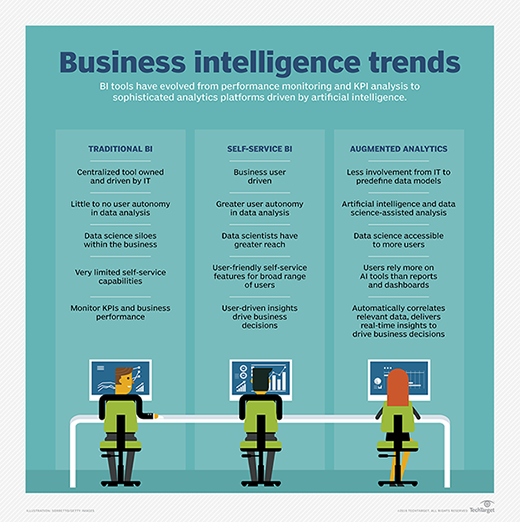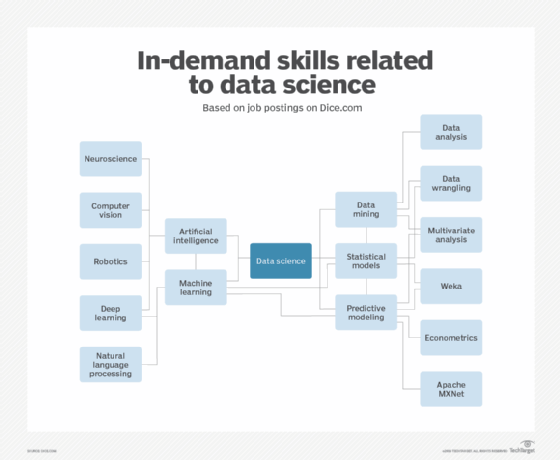business analytics
What is business analytics?
Business analytics (BA) is a set of disciplines and technologies for solving business problems using data analysis, statistical models and other quantitative methods. It involves an iterative, methodical exploration of an organization's data, with an emphasis on statistical analysis, to drive decision-making.
Data-driven companies treat their data as a business asset and actively look for ways to turn it into a competitive advantage. Success with business analytics depends on data quality, skilled analysts who understand the technologies and the business, and a commitment to using data to gain insights that inform business decisions.
How business analytics works
Before any data analysis takes place, business analytics starts with several foundational processes:
- Determining the business goal of the analysis.
- Selecting an analysis methodology.
- Getting business data to support the analysis, often from various systems and sources.
- Cleansing and integrating data into a single repository, such as a data warehouse or data mart.
Initial analysis is typically performed on a smaller sample data set. Analytics tools range from spreadsheets with statistical functions to complex data mining and predictive modeling applications. Patterns and relationships in the raw data are revealed. Then new questions are asked, and the analytic process repeats until the business goal is met.
Deployment of predictive models for business analytics involves a statistical process known as scoring and uses records typically located in a database. Scores help enterprises make informed, real-time decisions within applications and business processes.
Business analytics also supports tactical decision-making in response to unforeseen events. Often the decision-making is automated using artificial intelligence to support real-time responses.
Types of business analytics
Different types of business analytics include the following:
- Descriptive analytics tracks key performance indicators (KPIs) to understand the present state of a business.
- Predictive analytics analyzes trend data to assess the likelihood of future outcomes.
- Prescriptive analytics uses past performance to generate recommendations for handling similar situations in the future.
Some schools of thought include a fourth approach, diagnostic analytics. It's similar to descriptive analytics, analyzing the state of a business and diagnosing why certain events and outcomes happened.

Business analytics vs. business intelligence
The terms business intelligence (BI) and business analytics are often used interchangeably. However, there are key differences.
Companies usually start with BI before implementing business analytics. BI analyzes business operations to determine what practices have worked and where opportunities for improvement lie. It uses descriptive analytics to do this.
In contrast, business analytics focuses on predictive analytics, generating actionable insights for decision-makers. Instead of summarizing past data points, business analytics aims to predict trends.
The data collected using BI lays the groundwork for BA. From that data, companies can choose specific areas to analyze further using business analytics.

Business analytics vs. data analytics
Data analytics is the analysis of data sets to draw conclusions about the information they contain. Data analytics doesn't have to be used in pursuit of business goals or insights. It's a broader practice that includes business analytics.
Business analytics involves using data analytics tools in pursuit of fundamental business insights. However, because it's a general term, data analytics is sometimes used interchangeably with business analytics.
Business analytics vs. data science
Data science uses analytics to inform decision-making. Data scientists explore data using advanced statistical methods. They allow the features in the data to guide their analysis. The more advanced areas of business analytics resemble data science, but there's a distinction between what data scientists and business analysts do.
Even when advanced statistical algorithms are applied to data sets, it doesn't necessarily mean data science is involved. True data science uses custom coding and explores answers to open-ended questions. In contrast, business analytics excels at solving a specific question or problem.

Benefits of business analytics
The key benefit of business analytics is that it can help organizations identify patterns in data and generate new insights. With this information, they can improve existing processes and identify new strategies. Some other benefits of business analytics include the following:

- Improved decision-making. Business analytics provides actionable insights that spur organizations to make more informed, data-driven decisions.
- Business optimization. Business analytics can identify and help mitigate recurring issues that keep processes from operating smoothly, such as steps in a workflow that take longer than they should. Also, resource allocation and use can be monitored to identify ways to cut costs.
- Competitive advantage. Data on market trends can be analyzed to identify patterns and trends that lead to better strategies for reaching customers and responding quickly to demand trends.
- Personalized customer service and marketing. Business analytics provides metrics on different types of customers and their buying preferences that can be used to create more personalized service and marketing strategies that improve customer engagement and provide a better customer experience.
Common challenges of business analytics
Businesses might encounter both business analytics and BI challenges when trying to implement a business analytics strategy:
- Too many data sources. There is an increasingly large spectrum of internet-connected devices generating business data. In many cases, they're generating different types of data that must be integrated into an analytics strategy. However, the more complex a data set becomes, the harder it is to use it as part of an analytics framework.
- Lack of skills. The demand for employees with the data analytics skills necessary to process BA data has grown. Some businesses, particularly small and medium-sized businesses, might have difficulty hiring people with the expertise and skills they need.
- Data storage limitations. Before a business can begin to decide how it will process data, it must decide where to store it. For instance, a data lake can be used to capture large volumes of unstructured data.
Business analytics tools
There are several business analytics and BI tools that can automate advanced data analytics functions. In many cases, they require few of the specialized skills or deep knowledge of the programming languages used in data science.
These tools help businesses organize and make use of the massive amounts of data that modern internet of things and enterprise cloud applications generate. They come as part of supply chain management, enterprise resource planning and customer relationship management applications.
Business analytics tools are used in many ways. For example, they can identify customers who are likely to cancel a service offering subscription. A company would first take aggregate data from enterprise applications, using a DataOps analytics platform like DataKitchen. Then it would use a business analytics tool to present that data to employees and help them identify customers at risk of canceling a contract or becoming less engaged with the company.
When choosing a business analytics tool, organizations should consider the following:
- The sources where their data comes from.
- The type of data being analyzed.
- How easy the tool is to use.
A good business analytics tool is intuitive and user-friendly. It also provides a full suite of features for more advanced analytics.
A sampling of business analytics tools as compiled by Gartner includes Amazon QuickSight, Domo, Google Looker, Microsoft Power BI, MicroStrategy, Qlik Sense, SAP BusinessObjects BI Suite, Sisense Fusion Analytics and Tableau.
Roles and responsibilities of a business analyst
Business analytics professionals' main responsibility is to collect and analyze data to influence strategic decisions that a business makes. Some initiatives they might provide analysis for include the following:
- Identifying strategic opportunities from data patterns.
- Identifying potential problems facing the business and coming up with solutions.
- Creating a budget and business forecast.
- Monitoring progress with business initiatives.
- Reporting progress on business objectives back to stakeholders.
- Understanding KPIs.
- Understanding regulatory and reporting requirements.
Business analysts must have a mixture of hard skills and soft skills. A business analyst doesn't need a deep understanding of IT but does need to understand how systems work together. Some business analysts start their career in an IT-centric role and then move into a business analytics role.
When recruiting for these jobs, employers typically look for detail-oriented people with good communications skills. They need to have capabilities in some or all of these areas: cost-benefit analysis; process modeling; stakeholder analysis; analytical problem-solving; and IT systems, particularly databases, data visualization, data management, business analytics and business intelligence.
Certifications and courses for business analytics
Certifications for business analysts and related careers include the following:
- Axelos Information Technology Infrastructure Library 4 certification.
- International Institute of Business Analysis (IIBA) Entry Certificate in Business Analysis.
- IIBA Certification of Capability in Business Analysis.
- IIBA Agile Analysis Certification.
- International Qualification Board for Business Analysts Certified Foundation Level Business Analysis.
- International Requirements Engineering Board Certified Professional for Requirements Engineering.
- Project Management Institute (PMI) Professional in Business Analysis.
- PMI Disciplined Agile Scrum Master.
There are several ways to prepare for business analytics certification exams. One option is to take an online course offered by self-directed learning sites, such as Udemy. Users can subscribe to these sites to access educational content, including structured bootcamp courses. The time needed to complete these courses varies from days to months.
Another route to certification is to pursue a master's degree in business analytics. This path is more expensive and time-intensive, taking a year or two to complete.
Career and salary trends in business analytics
There are several career paths for a person with a business analytics background. Some common job titles and annual salaries as of 2024, according to PayScale and Salary.com, include the following:
- Senior business analyst. PayScale's average annual salary for a senior business analyst is $89,966. Salary.com posts an average salary of $89,853.
- Business systems analyst. PayScale's average annual salary for a business systems analyst is $73,362. Salary.com posts $66,320.
- Business analyst. PayScale's average annual salary for a general business analyst is $67,149. Salary.com posts a range from $60,300 to $74,203.
- BI data analyst. The average annual salary for a BI data analyst is $74,071. Salary.com posts $70,017.
- Junior business analyst. The average annual salary for a junior business analyst is $54,682. Salary.com posts $66,860.
Future of the business analytics job market
Given the rise of big data, business analysts will continue to be important in the coming years. More data means a greater need for analyses, which all but assures job security in this field.
The Bureau of Labor Statistics (BLS) doesn't collect data on business analytics roles. However, it does monitor related analyst positions, such as operations research analyst and computer systems analyst. Jobs in operations research are expected to grow 23% from 109,900 in 2022 to 134,600 in 2032, according to the BLS. Computer systems analyst positions are expected to grow 10% from 531,400 to 582,500 in that same time frame. Both are above average growth rates, according to the BLS.
The capabilities of data science tools have expanded dramatically in the last few years. Learn more about the most up-to-date data science tools to add to your skill set.







